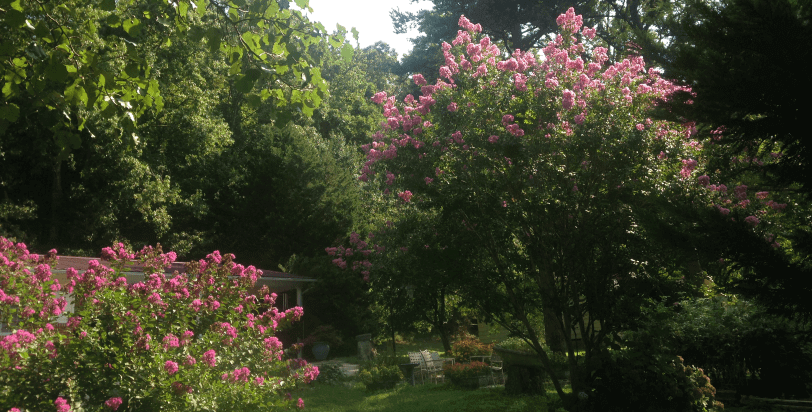Crape Myrtle or Crepe Myrtle are shrubs and small trees that are known for their large panicles of tiny flowers that are crinkled like crepe paper. Colors range from shades of purple, pink, red and white, depending on variety. These colorful blooms start showing off in summer and usually last through early fall.
Crape Myrtles are very attractive and serve many landscape purposes. These awesome shrubs are typically categorized as being dwarf, medium or large. Because of their wide range of sizes, Crape Myrtles can be used in a variety of ways in both home and commercial landscapes.
Dwarf Crape Myrtle
Dwarf varieties of Crape Myrtle can grow anywhere from 2 feet to 5 feet tall and are perfect for adding color to small sunny places. The smaller dwarfs can be used in containers, rock gardens and perennial borders. Slightly larger dwarfs may be used for foundation plantings or borders.
Medium Crape Myrtle
Medium Crape Myrtles range in height from 5 feet to 15 feet tall. They can be used to line walkways and driveways or as an accent. The smaller medium Crape Myrtles are generally kept in shrub form. The taller medium varieties can be trimmed up and under-planted with perennials.
Large Crape Myrtle
Large Crape Myrtles can grow 15 feet to 30 feet high. These magnificent beauties are great as specimens or used as street trees. They can be limbed up to show their multi-trunk tree form. The bark on Crape Myrtle exfoliates or peels off, revealing smooth sometimes mottled grey and cinnamon colors underneath. The peeling bark gives Crape Myrtle year-round interest.
Growing Conditions
Crape Myrtles are easy to grow and can tolerate most soil conditions. They prefer full sunlight and don’t like shade. They can be planted in summer, so you can choose the color you want while they are blooming! Make sure to keep the soil moist during the first summer. When properly located in the landscape, Crape Myrtle is one of the toughest and most showy summer flowering shrubs.
Varieties
Here is a list of some favorite varieties, their color, approximate height at maturity and other distinguishing features. These varieties are all winter hardy in East Tennessee.
- Acoma – white- 10’t x 10’w- attractive bark
- America-red/pink- 3’ to 5’t- red buds open to pink flowers
- Coral Magic – coral pink- 6’ to 10’t- reddish new growth
- Double Feature – ruby red-6’ to 8’t- reblooms and no seed heads
- Dynamite – cherry red- 10’ to 20’t- orange/red fall color
- Infinitini Magenta – dark pink/red- 2’ to 4’t- miniature
- Infinitini Orchid – lavender- 2’ to 4’t- miniature
- Midnight Magic – dark pink- 4’ to 6’t- purple/maroon foliage
- Moonlight Magic– snowy white- 8’ to 12’t- deep maroon leaves
- Muskogee – light lavender- 20’ to 30’t- mottled gray/brown exfoliating bark
- Natchez – white- 25’ to 30’t- exfoliating bark with smooth cinnamon underneath
- Pink Velour – bright pink- 8’ to 10’t- burgundy foliage
- Plum Magic – bright fuchsia- plum/purple leaves
- Pocomoke – rosy pink- 3’ to 5’ tall and wide- dwarf
- Red Magic – true red- 6’ to 10’t- reddish new growth
- Red Rocket -ruby red- 15’ to 20’t- upright growth habit
- Rhapsody Pink – soft pink- 10’ to 15’t- dark wine new growth
- Royalty – dark royal purple- 6’ to 8’t- cold hardy semi-dwarf
- Sioux – vibrant pink- 14’ to 20’t- red fall foliage
- Siren Red – oxblood red- 6’ to 12’t- can be pruned for tree or shrub
- Tonto – bright red- 10’t x 10’w- good fall foliage color
- Tuscarora – reddish coral- 20’ to 25’t- mottled light brown exfoliating bark
If you have a full sun area you are working on, check out Best Blooming Heat Tolerant Plants For East Tennessee!

